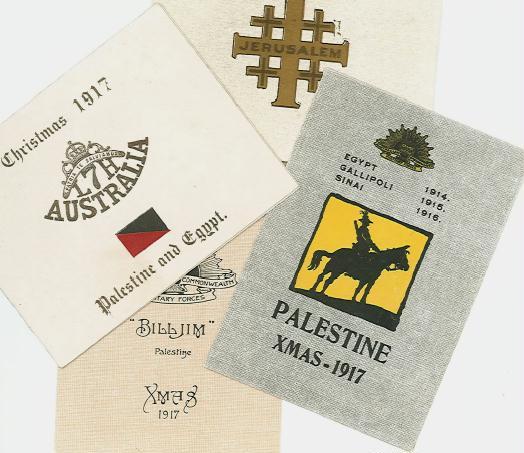Christmas in Jerusalem

Selection of Christmas cards sent from Palestine in 1917.
Jerusalem fell to the British and Australians just before Christmas 1917. The historic and religious significance of Jerusalem was not lost on the Australians, with many writing in letters and diaries of their excitement in glimpsing the holy city for the first time.
The Official History mentions that within a matter of days of occupying the city, the bazaars, stalls and shops were open for business and Australians were seen casually spending their money in the days before Christmas. Many of the troops bivouacked outside of the city, however, had a less relaxing time, spending the Christmas season battling to save tents and supplies against severe weather conditions. Following the capture of Jerusalem, General Sir Edmund Allenby took the decision to rest the troops. Long periods of time in the field and the rapid push to victory at Jerusalem had taken its toll on general health. Troops stationed in the city had some opportunities over the Christmas season to spend time sight-seeing. Some recorded in their diaries the historic places they had visited and photographed. Thomas Hunt wrote: “We were shown where Christ was tried by Herod and we entered the church which contains a portion of the oldest wall and three arches of the house where Christ was condemned and where he started to carry his cross.”
The 10th Australian Light Horse was the first Australian Regiment to enter the city. Some units slept in houses for the first time in three years. Other less lucky regiments were bivouacked in the regions surrounding Jerusalem. Leslie Horder of the 1st Light Horse Regiment wrote of the incessant rain. He mentioned on the 7 December that he hoped the Turks would hand over Jerusalem until the rain stopped. Horder was out in the weather on Christmas Eve and wrote in his diary, “Hurricane blew all night from the sea with a cold rain, most miserable”. He noted that his Christmas day was not much better but the Christmas Comforts Fund gifts were “muchly enjoyed”.
Bert Penna and George Hunt both recorded being washed out of their "bivvies" on Christmas Eve. Hunt wrote that there was great enthusiasm when "we were told that we could see Jerusalem". He mentioned "much feeling passing through the troops on the wonderful sights ahead of us". The songs "Jerusalem the golden and The Holy City were both murdered all along the line till we actually entered the streets”. Penna wrote that this wet and cold Christmas would never be forgotten. “Washed out of our bivvies we had to hang on to our bully beef, that was our luxury for breakfast, dinner and tea, to save it from being washed away. And the thanks we would receive on wishing each other a Merry Christmas would be, (now don’t get shocked mother, but blame the rain) I wish you to hell. Well that was the feeling of all of us.”
Sources
Archival (personal papers): PR91/140 Trooper George Thomas Hunt 3DRL/6595 Sergeant Leslie S. Horder PR00028 Sergeant William Herbert Penna
Published: Bill Gammage, The broken years: Australian soldiers in the great war (Canberra: Australian National University Press, 1974) H. S. Gullett, The Australian Imperial Force in Sinai and Palestine (Sydney: Angus & Robertson, 1941)